
Crater Lake is a volcanic crater lake in south-central Oregon in the Western United States. It is the main feature of Crater Lake National Park and is famous for its deep blue color and water clarity. The lake partly fills a 2,148-foot-deep (655 m) caldera that was formed around 7,700 years ago by the collapse of the volcano Mount Mazama. No rivers flow into or out of the lake; the evaporation is compensated for by rain and snowfall at a rate such that the total amount of water is replaced every 250 years. With a depth of 1,949 feet (594 m), the lake is the deepest in the United States. In the world, it ranks tenth for maximum depth, as well as third for mean (average) depth.
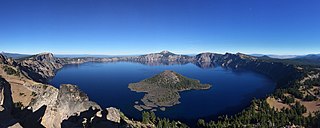
Crater Lake National Park is an American national park located in southern Oregon. Established in 1902, Crater Lake is the fifth-oldest national park in the United States and the only national park in Oregon. The park encompasses the caldera of Crater Lake, a remnant of Mount Mazama, a destroyed volcano, and the surrounding hills and forests.

Copernicus is a lunar impact crater located in eastern Oceanus Procellarum. It was named after the astronomer Nicolaus Copernicus. It typifies craters that formed during the Copernican period in that it has a prominent ray system. It may have been created by debris from the breakup of the parent body of asteroid 495 Eulalia 800 million years ago.

Manicouagan Reservoir is an annular lake in central Quebec, Canada, covering an area of 1,942 km2 (750 sq mi). The lake island in its centre is known as René-Levasseur Island, and its highest point is Mount Babel. The structure was created 214 (±1) million years ago, in the Late Triassic, by the impact of a meteorite 5 km (3 mi) in diameter. The lake and island are clearly seen from space and are sometimes called the "eye of Quebec". The lake has a volume of 137.9 km3 (33.1 cu mi).

Lappajärvi is a lake in Finland, in the municipalities of Lappajärvi, Alajärvi and Vimpeli. It is formed in a 23 km (14 mi) wide, partly eroded meteorite impact crater. The lake is part of Ähtävänjoki basin together with Lake Evijärvi that is located downstream (north) of it.
Obolon' crater is a 20 km (12 mi) diameter buried meteorite impact crater situated about 200 km (120 mi) southeast of Kyiv in Ukraine . The site has been drilled, which revealed the presence of shocked minerals and impact melt rock; the high chlorine content of the latter suggesting that the area was covered by shallow sea at the time of impact. One estimate puts the age at 169 ± 7 million years.

Rochechouart impact structure or Rochechouart astrobleme is an impact structure in France. Erosion has over the millions of years mostly destroyed its impact crater, the initial surface expression of the asteroid impact leaving highly deformed bedrock and fragments of the crater's floor as evidence of it.
Saint Martin is an impact structure in Manitoba, Canada. It is located in the northern part of the Rural Municipality of Grahamdale, northwest of Lake St. Martin.

Lunar craters are impact craters on Earth's Moon. The Moon's surface has many craters, all of which were formed by impacts. The International Astronomical Union currently recognizes 9,137 craters, of which 1,675 have been dated.

Oudemans is a crater on Mars, approximately 90 kilometers in diameter, named after Dutch astronomer Jean Abraham Chrétien Oudemans (1827–1906).

The Diamond Craters is a monogenetic volcanic field about 40 miles (64 km) southeast of Burns, Oregon. The field consists of a 27-square-mile (70 km2) area of basaltic lava flows, cinder cones, and maars. The reexamination of radiocarbon dates from older studies and interpretation of paleomagnetic data and new radiocarbon dates limits the eruption of volcanic vents in this volcanic field to the time period between 7320 and 7790 calendar years B.P.
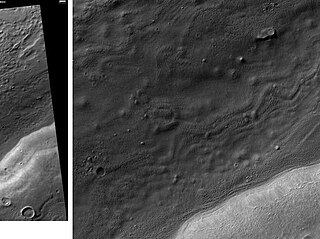
Centauri Montes is a group of mountains in the Hellas quadrangle of Mars, located at 38.67°S 95.52°E. It is 270 km across and was named after the albedo feature Centauri Lacus. According to NASA, there are light-sediment gulley deposits that have formed in a crater around the Centauri Montes.
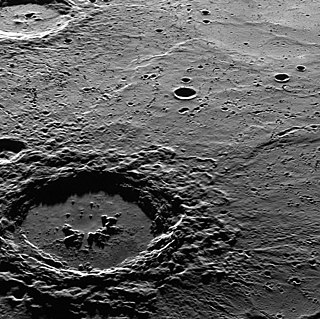
Hokusai is a rayed impact crater on Mercury, which was discovered in 1991 by ground-based radar observations conducted at Goldstone Observatory. The crater was initially known as feature B. Its appearance was so dissimilar to other impact craters that it was once thought to be a shield volcano. However, improved radar images by the Arecibo Observatory obtained later in 2000–2005 clearly showed that feature B is an impact crater with an extensive ray system. The bright appearance of rays in the radio images indicates that the crater is geologically young; fresh impact ejecta has a rough surface, which leads to strong scattering of radio waves.
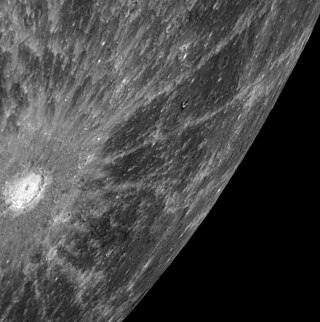
Debussy is a rayed impact crater on Mercury, which was discovered in 1969 by low resolution ground-based radar observations obtained by the Goldstone Observatory. Later in 1990–2005 it was imaged in more detail by the Arecibo Observatory. The crater was initially known as the feature A. The bright appearance of rays in the radar images indicates that the crater is geologically young, because fresh and rough surfaces of young impact craters are good scatterers of radio waves.
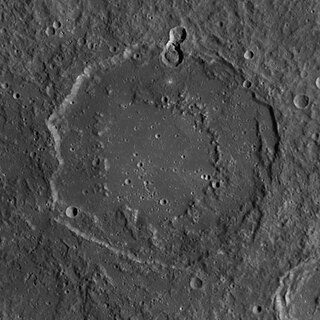
Nabokov is a crater on Mercury. Its name was adopted by the International Astronomical Union (IAU) on April 24, 2012. Nabokov is named for the Russian and American author Vladimir Nabokov.

Vonnegut is a crater on Mercury, near the north pole. It was named by the IAU in 2017 after the American author Kurt Vonnegut. Part of Vonnegut's 1959 novel The Sirens of Titan takes place on Mercury. The crater was referred to as e5 in scientific literature prior to naming.















